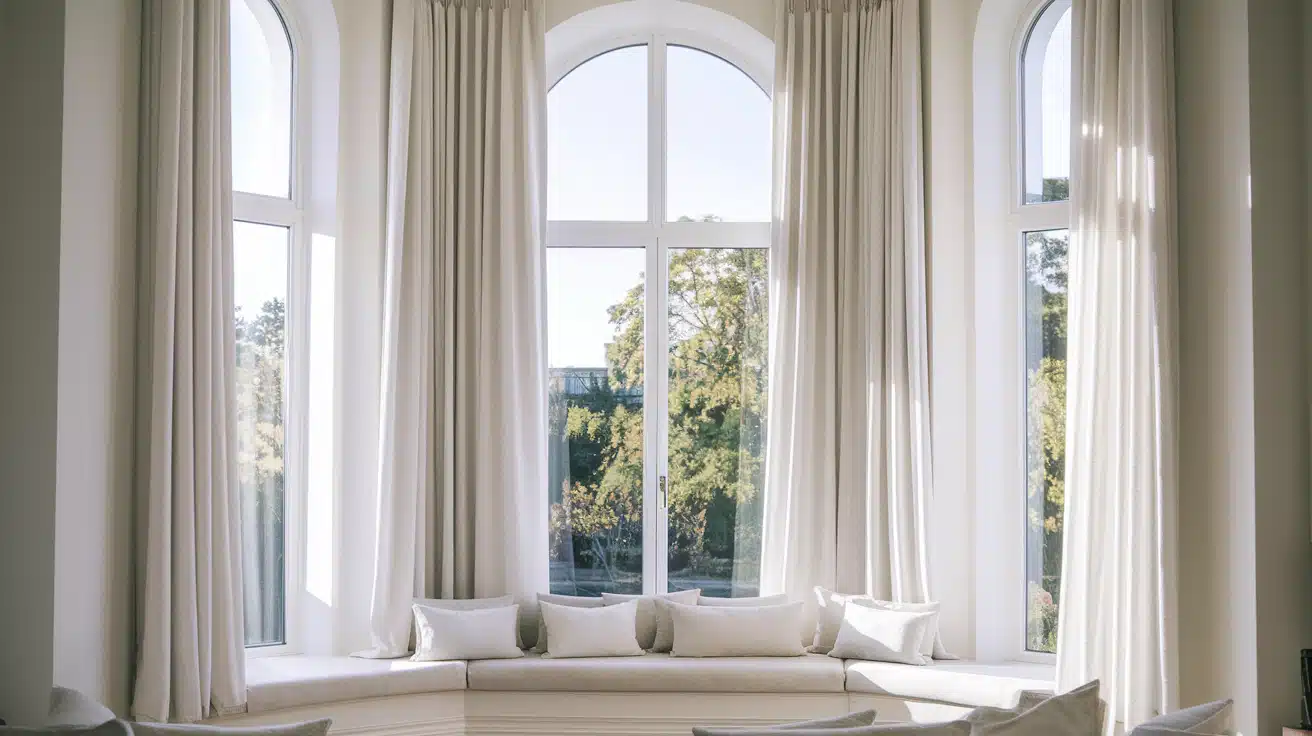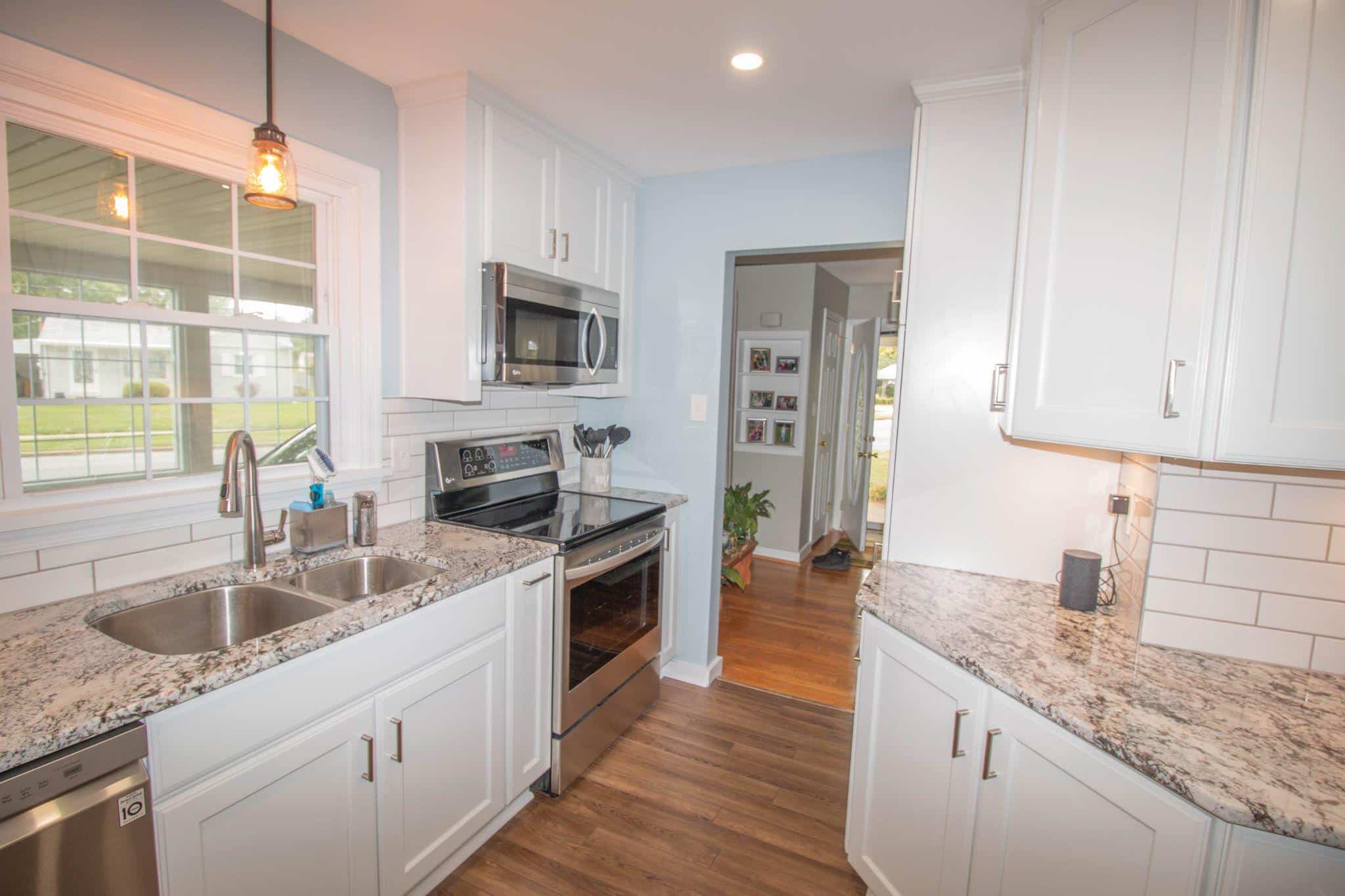Have you ever wondered why some curtains make a room feel perfect while others just look out of place?
The secret lies in choosing the right curtain length.
Selecting the proper curtain length does more than just cover your windows – it shapes how your entire room feels.
When done right, curtains can make your windows appear larger and your ceilings higher.
When done wrong, they can make your space feel awkward and unfinished.
In this guide, we’ll walk you through everything you need to know about curtain lengths.
From standard sizes to measuring tips, you’ll learn how to choose the perfect length for your windows.
We’ll help you avoid common mistakes and show you how different lengths can transform your room’s appearance.
Understanding Standard Curtain Lengths
When you shop for curtains, you’ll notice they come in several standard lengths.
These common measurements exist to fit most typical window sizes and ceiling heights found in homes.
The standard lengths include:
| Curtain Length | Description |
|---|---|
| 63 inches | Perfect for windows that sit above furniture like kitchen counters or console tables. These shorter panels work well in casual spaces. |
| 84 inches | This length suits most standard 8-foot ceilings when mounted just above the window frame. It’s among the most commonly used sizes in homes. |
| 96 inches | Ideal for taller windows or when you want to mount your curtain rod closer to the ceiling in rooms with 9-foot heights. |
| 108 inches | Made for larger windows and higher ceilings, these panels create a more substantial look in spacious rooms. |
| 120 inches | Reserved for very tall windows or high ceilings, these extra-long panels make a notable statement in grand spaces. |
While these standard sizes fit many homes, they might not work perfectly for every window.
Your specific needs could fall between these measurements, which is when custom options become worth considering.
Remember that the right length depends not just on your window size, but also on the look you want to create and how you plan to hang your curtains.
Different Curtain Length Styles
Let me break down each curtain length style and explain how it can transform your space:
1. Sill Length
Picture a kitchen window dressed with curtains that stop precisely at the window sill.
This crisp, clean look works perfectly in spaces where practicality matters most.
In kitchens, especially above sinks or counters, these shorter curtains stay clear of water splashes and food preparation areas.
While some consider this style more traditional, it remains a practical choice for busy areas where longer curtains might interfere with daily activities.
2. Apron Length
Extending just four inches below the window sill, apron-length curtains offer a middle ground between short and long styles.
These curtains add a finished look to casual spaces like breakfast nooks or family rooms.
They’re particularly useful when you have radiators or furniture placed under windows.
The extra few inches of fabric create a more complete look than sill length yet maintain the practicality of shorter curtains.
3. Floor Length
Consider floor-length curtains the most adaptable option in window treatments.
Hanging just half an inch above the floor, these panels create a polished, professional appearance without the maintenance concerns of longer styles.
They work beautifully in any room, from living spaces to bedrooms, offering a perfect blend of style and function.
This length maintains clean lines while making your windows appear taller and your ceilings higher.
4. Puddle Length
The most formal of all curtain lengths, puddle-length panels create a luxurious pool of fabric on the floor.
With an extra three to six inches of material, these curtains bring drama and opulence to formal spaces.
They work best in low-traffic areas like formal dining rooms or master bedrooms where they won’t be disturbed frequently.
While they require more attention to maintain their appearance, the rich, flowing effect they create makes a stunning statement in the right setting.
Choosing The Right Curtain For Your Window
Let’s explore the key factors that help you select the perfect curtains for your space:
1. Room Purpose And Traffic
Consider how you use the room when selecting curtain length.
High-traffic areas like living rooms benefit from floor-length panels that stay clear of feet, while formal dining rooms can handle more luxurious puddle-length options.
For kitchens and bathrooms, practical sill-length curtains make more sense.
2. Fabric Selection
The type of fabric influences how your curtains hang:
- Light fabrics like cotton and linen: Work well with all lengths, create a casual feel
- Medium-weight fabrics like polyester blends: Ideal for floor-length styles
- Heavy fabrics like velvet: Perfect for puddle lengths
- Sheer materials: Best used in floor-length or combined with other panels
3. Window Size And Placement
Your window’s dimensions matter:
- Tall windows: Longer curtains enhance vertical lines
- Wide windows: Consider panel width as well as length
- Windows above furniture: Often need shorter lengths
- Bay windows: May require special length considerations
4. Light Control And Privacy
Think about your needs:
- Full coverage: Longer lengths offer better light blocking
- Partial privacy: Sill or apron lengths might suffice
- Layered solutions: Combine sheers with longer panels
- Seasonal changes: Consider how different lengths affect natural light
5. Maintenance Requirements
Be realistic about upkeep:
- Floor length: Easiest to maintain
- Puddle length: Requires regular adjustment
- Sill-length: Simple to clean
- High-traffic areas: Choose practical lengths that won’t collect dirt
Installation Tips
1. Best Practices For Installing Different Lengths
Install the right hardware properly.
Mount the rod 4-6 inches above the window frame.
For wide windows, extend it 3-10 inches beyond each side.
Use a level to mark points and secure brackets to wall studs or with suitable anchors. For heavy or puddle-length curtains, add support brackets to avoid sagging.
2. How to Ensure Curtains Hang Properly
Hanging curtains requires attention to detail. Iron or steam panels to remove creases.
Ensure brackets are level and secure. Space rings or clips evenly.
For floor-length curtains, measure and mark multiple points for an even hem.
Adjust folds and pleats for a uniform look.
3. Advice On Maintaining Curtain Appearance
Regular maintenance keeps curtains fresh.
Vacuum monthly with a brush to remove dust. Reshape puddle-length styles weekly.
Rotate panels if one side gets more sun. Steam clean every few months to preserve shape and remove wrinkles.
For machine-washable curtains, follow care labels and rehang slightly damp for natural pleats.
4. Special Considerations For Different Styles
Each length needs specific attention during installation.
Sill-length curtains require precise measurement for a clean window line.
Floor-length panels should hang the right distance from the floor.
Puddle-length curtains need extra time for arranging fabric pools. Double-check measurements before permanent alterations.
How To Choose the Right Length For Curtain
Getting the right measurements is key to achieving the perfect curtain fit. Here’s what you need and how to do it correctly:
Tools You’ll Need:
- Metal tape measure
- Step stool or ladder
- Pencil and paper
- Calculator
Step-By-Step Measuring Guide
Step 1 – Decide on Rod Placement Start by marking where you’ll mount your curtain rod.
For the best look, position the rod 4-6 inches above your window frame. This placement makes your window appear taller.
If you have high ceilings, you can mount the rod even higher.
Step 2 – Measure from Rod to Floor With your tape measure, start at the planned rod location and measure down to the floor.
Keep the tape straight and taut for accuracy.
If you plan to use rings to hang your curtains, add their length to your measurement.
Step 3 – Consider Your Desired Style Based on your preferred look, adjust your measurements:
- For floor length: Subtract 1/2 inch from your measurement
- For a slight break: Add 1 inch to your measurement
- For a pooled look: Add 3-6 inches to your measurement
Tips For Accurate Measuring
- Measure each window separately, even if they appear identical
- Take multiple measurements across the window’s width
- Write down all measurements immediately
- Double-check your numbers before purchasing
- Account for uneven floors by measuring at different points
Conclusion
Selecting the right curtain length transforms an ordinary window into a key design element in your room.
Either you choose practical sill-length curtains for your kitchen, classic floor-length panels for your living room, or luxurious puddle-length drapes for your dining area, each style serves a unique purpose.
Remember, successful window treatments start with careful measuring and thoughtful consideration of your room’s needs.
Take time to evaluate your space, consider maintenance requirements, and select appropriate lengths for each room’s function.
We hope this guide helps you make informed decisions about your window treatments.













